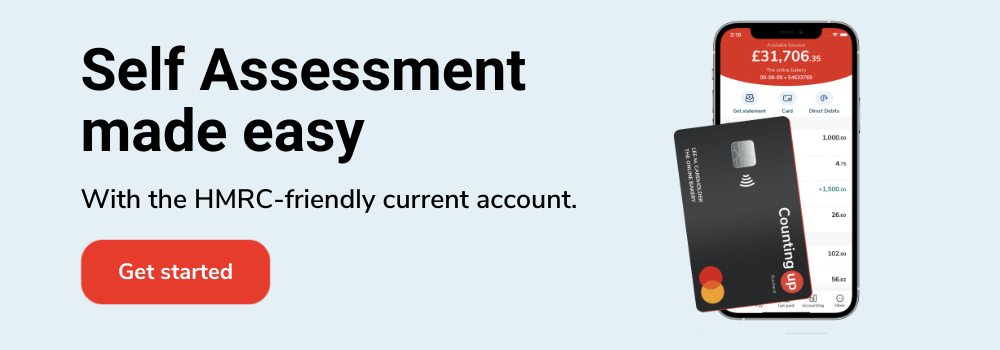Self Assessment guide: how to claim mileage
Table of Contents
Whether you’re a sole trader or the owner of a small company, running a business can involve driving to different locations. Keeping track of your business mileage may seem tedious, but all the little trips you make can add up. Knowing how to claim mileage allowance relief on your self-assessment is essential to save you some money.
In this guide, you’ll learn:
- What are HMRC’s mileage tax relief rules?
- What are the mileage allowance rates?
- How does the allowance work for sole traders?
- What counts as a business-related journey?
- How to claim mileage allowance on your self-assessment
What are HMRC’s mileage tax relief rules?
HMRC (or HM Revenue & Customs) lets you claim money back from the government on vehicles you use for work, including cars, vans, motorcycles, and bicycles. You’re only allowed to claim on business-related journeys, which we’ll explain below.
How much you can claim depends on whether you’re using a personal vehicle that you bought with your own money or a company vehicle that your company purchased solely for business purposes.
You claim the total business mileage amount as tax relief on your self-assessment tax return.
Using a personal vehicle
When using your personal vehicle for work, you could claim tax relief on the approved mileage rate (explained below) that covers the cost of owning and running it.
However, you can’t claim back on separate costs, such as:
- Fuel
- Electricity
- Road tax
- Repairs
To work out how much you can claim, you need to keep records of the dates and mileage of your business journeys. Be sure to add up the mileage for each vehicle you’ve used for work, as you’ll need to claim for each one. We’ll explain the approved mileage allowance rates (AMAP) later in this article.
Using a company car
For business trips you made in your company car, you can claim tax relief on the money you spent on fuel and electricity. Remember to keep records of the actual cost of the fuel, as you’ll need to include it in your self-assessment for business expenses.
What are the mileage allowance rates?
The approved mileage allowance rates (AMAP) are:
- Company cars and vans: 45p per mile for the first 10,000 miles, 25p thereafter.
- Motorcycles: 24p before and after 10,000 miles
- Bicycles: 20p before and after 10,000 miles
Note that there currently isn’t a mileage claim for sole traders using bicycles.
How does the allowance work for sole traders?
If you’re a sole trader, you can use simplified expenses, which are a way for you to work out what business expenses you can claim using the government’s standard rates, called ‘flat rates’.
Using simplified expenses means you’ll claim HMRC’s standard allowance rates for tax relief. The flat rates are also 45p per mile for the first 10,000 miles and 25p when you go over.
What counts as a business-related journey?
Necessary business journeys are ones that you have to make to do your job or go someplace other than your usual workspace to work.
These trips include:
- Travelling to and from client meetings or appointments
- Running errands like visiting the bank or buying office supplies
- Travelling from one office to another
Travelling to and from your regular workplace doesn’t count as business-related travel, even if you stop to carry out a business-related task on the way, like buying office supplies.
You can also claim tax relief from travelling to a temporary workplace, meaning you’ll work there for less than 24 hours or be there for less than 40% of your time.
How to claim mileage allowance relief on self-assessment
As a small business owner, you may prefer to claim the flat rates since it involves fewer calculations and saves you from working out your total motor expenses across the year. Instead, you simply calculate the total mileage for the business journeys and submit it to HMRC.
You add up each of your total mileage allowance amounts and add them to your self-assessment tax return.
For a contractor with a vehicle that has done under 10,000 miles, a mileage log for one business journey might look like this:
- Time: 9 AM
- Date: 17/05/2021
- Purpose (business or personal): Business
- Trip details: Home repairs for client
- Start location: Office
- End location: Client’s home
- Total miles: 10
- Total mileage allowance (at 45p per mile): 10 x 0.45 = £4.50
Points to take note of when claiming mileage allowance
There are a few things to keep in mind when claiming tax relief on mileage expenses.
First, once you’ve chosen a method, you must stick to it until you replace the vehicle.
If your annual turnover ever exceeds the VAT threshold (£85,000 for the 2021/22 financial year), you can no longer claim the flat rates for mileage.
You also can’t use flat rates if you bought your vehicle with a capital allowance, which is tax relief on long-term business asset purchases.
Finally, keeping track of your mileage details doesn’t have to be a time-consuming headache if you use the right tools. For example, apps like MileIQ make it easier to track your mileage consistently.
Keep track of your taxes with Countingup
When you sign up for a Countingup business current account, you get free built-in accounting software that allows you and your accountant to keep on top of your finances with ease.
We’ve automated the time-consuming aspects of bookkeeping and tax planning so you can focus on running your business. You also receive updates about profit-and-loss statements, cash flow insights, tax estimates, and the ability to create and send invoices in seconds.





